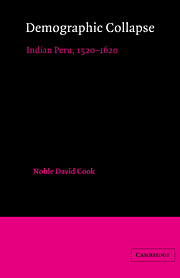Book contents
- Frontmatter
- Contents
- List of tables, figures, and maps
- Preface
- Introduction: The problem in perspective
- Part I Peru's preconquest population
- Part II Demographic collapse
- 8 First contact: north coast
- 9 Center of Spanish control: middle coast
- 10 Disease, earthquakes, and droughts: south coast
- 11 Intermediate area: northern highlands
- 12 Mining and population in the central sierra
- 13 The Indian heartland: southern highlands
- 14 An overview
- Abbreviations used in notes
- Notes
- Bibliography
- Index
- Titles in the series
12 - Mining and population in the central sierra
Published online by Cambridge University Press: 02 December 2009
- Frontmatter
- Contents
- List of tables, figures, and maps
- Preface
- Introduction: The problem in perspective
- Part I Peru's preconquest population
- Part II Demographic collapse
- 8 First contact: north coast
- 9 Center of Spanish control: middle coast
- 10 Disease, earthquakes, and droughts: south coast
- 11 Intermediate area: northern highlands
- 12 Mining and population in the central sierra
- 13 The Indian heartland: southern highlands
- 14 An overview
- Abbreviations used in notes
- Notes
- Bibliography
- Index
- Titles in the series
Summary
Some absent themselves from their communities to avoid going to the mines where they would suffer agony and martyrdom, and in order to avoid experiencing such hell, hardship and torment of the devils, others flee the mines, and still others take to the roads to avoid the mines and would rather chance dying suddenly rather than to suffer a slow death. They say that they reach such a state because conttracting mercury sickness one dries up as a stick and has asthma, and cannot live day or night. It goes on in this manner a year or two and they die.
Felipe Guáman Poma de Ayala, La nueva crónica y buen gobierno, p. 333The central Peruvian highland corregimientos are in the heart of the Andean chain. The elevation of the area is high. The frigid, windswept pun a appears inhospitable but provides fodder for extensive flocks of llamas and alpacas, which are used for wool. Upper sections can also produce ichu and quinoa, a native cereal. Potatoes and other tuberous crops are grown in cool zones, and in the more temperate valleys wheat, corn, and other crops are cultivated. The central highlands are a major mining region of the Peruvian Andes. The modern Cerro de Pasco mining district is in the north; minor silver deposits were worked throughout the central highlands; famous mercury mines are located at Huancavelica in Chocorvos; and there was a major silver-mining center at Castrovirreyna in the southern part of the same corregimiento. In this chapter we shall examine the relationship between mining, which was so important in the central sierra, and population change.
- Type
- Chapter
- Information
- Demographic CollapseIndian Peru, 1520–1620, pp. 199 - 210Publisher: Cambridge University PressPrint publication year: 1982



